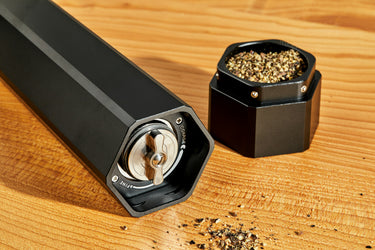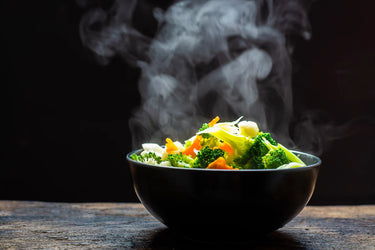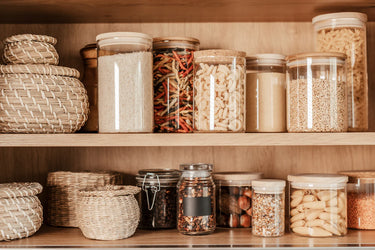A Handy Guide To Peppercorn Varietie

A high-quality pepper grinder isn’t just a statement piece to decorate the dinner table. No, this tool is crucial for unleashing the delicious aromas and flavor compounds inside pepper. This now-common spice was once as valuable as gold. Fair enough: pepper adds complex flavor to everything it touches.
There are five main varieties of peppercorns that you’ll find in the supermarket. Black peppercorns are the most common, but the white, green, and red kinds all have the same berry from the Piper nigrum plant, picked at different stages of ripeness. You might be surprised to learn that peppercorns are a type of drupe, a category of fruit that also contains olives, stone fruit, almonds, and mango. Originating on India’s Malabar coast, peppercorns became an extremely valuable commodity in the global spice trade. In ancient times, peppercorns were so valuable, they were used to pay taxes, rent, and dowries.
Though seed-filled chili peppers share a name, they’re a completely different plant than peppercorns. When explorers from Europe encountered chili peppers, they named them after the popular spice, which was dominating global trade at the time.
Peppercorns are a versatile and delicious spice that come in a variety of colors. Here’s our handy guide to the different varieties of peppercorns you’ll find in the supermarket.
Black Peppercorns
Likely the variety you’re most familiar with, black peppercorns boast a world of flavor, from spicy to pungent to fruity. Black peppercorns are picked when still green, then sun-dried until dark. Two varieties from India are easy to find worldwide: Malabar is the most common variety of black pepper, while Tellicherry (the largest of the crop) are a bit stronger and sweeter. As the spice spread around the globe, other countries started growing the plant, resulting in other varieties like Sarawak from Malaysia, Lampong from Indonesia, and Belem from Brazil. When buying peppercorns, look for a relatively uniform color. The darker they are, the more flavorful they’ll be.
How to use black peppercorns: Black peppercorns are an ideal-to pepper for everyday cooking, from Italian cacio e pepe pasta to salad dressings to roasted vegetables.
Green Peppercorns
Picked when unripe, green peppercorns are softer than the black kind. Their herbaceous, bright flavors offer a cue to their identity as a fruit. Perfect for pickling and adding to vinaigrette, or mixing in with black peppercorns for steak au poivre, green peppercorns are worth seeking out. You might also see jarred or canned green peppercorns, which are preserved in brine.
How to use green peppercorns: Use them in classic sauces where you’d use black peppercorns for a more mellow flavor that still brings a hint of heat. The brined kind are ideal for sprinkling on salads or using in marinades.
White Peppercorns
Milder than black peppercorns, white peppercorns are achieved by soaking nearly ripe berries in water and removing the skins before drying. Once dried, they have a white or nearly white hue. Though you’re likely to see a spectrum of hues from white to gray in most supermarkets, it’s worth seeking high-quality white peppercorns out for their earthy, mild flavor and mellow heat.
How to use white peppercorns: Choose white peppercorns when you want a subtle, complex peppery flavor but no black flecks. White gazpacho, cheese soufflé, or a rolled omelet are all good picks for white peppercorns.
Red Peppercorns
Rare to find, red peppercorns are left to fully ripen on the vine before drying to preserve their gorgeous hue. They have an intense fruity and floral flavor that’s not as strong as black pepper.
How to use red peppercorns: Like the other peppercorn varieties, the red ones can be used interchangeably with black. Try adding a dusting of finely ground red peppercorns to aked fish or open-faced goat cheese toast.
Pink Peppercorns
Though more common than the similarly-hued red variety, pink peppercorns don’t actually come from the Piper nigrum plant. Pink peppercorns hail from the fruits of pepper trees in Peru (schinus molle) and Brazil (schinus terebinthifolius), which are related to the cashew tree. Though they can stand up to a pepper grinder in a pinch, these soft berries are best crushed in a mortar and pestle or with a knife. Fruitier than black peppercorns, pink peppercorns are ideal for people who want pungency without too much heat. How to use pink peppercorns: While they can be used anywhere you’d use black peppercorns, try sprinkling pink peppercorns over popcorn, stirred into coconut milk curries, or mixed into into herbal cocktails.
Sichuan peppercorns
This popular Chinese staple is incredibly popular for its numbing heat. They’re not from the Piper nigrum plant, but can be used in dishes where you’d use black peppercorns but want more intense, tingly heat.
How to use Sichuan peppercorns: Stir Sichuan peppercorns into a spicy, cold dressing for noodles, add to a shrimp stir fry, or sprinkle over your pizza instead of chili flakes.
–
If you’re a heat-lover, play around with these different types of peppercorns. Though the pink and Sichuan kinds aren’t “true” peppercorns, that doesn’t really matter when it comes to cooking. Experiment swapping green in for black or Sichuan when you want an electrifying heat.
Experiment with different size grinds on your Hexmill pepper grinder to enjoy the full variety of peppercorn varieties. Use the fine grind for dishes where you want the flavor without any crunchy bits (vinaigrettes, eggs, and soups) and the coarser grind when you’re looking for more heat and added texture (grilled meats, roasted vegetables). If you want to keep the mill stocked with black peppercorns for easy everyday cooking, use a mortar and pestle to grind up the other colors.





